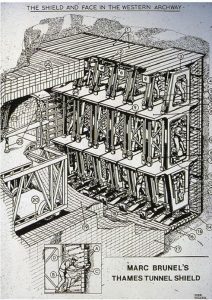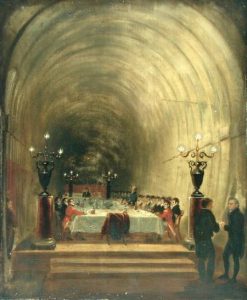To Isambard Kingdom Brunel, January 12th, 1828 seemed like just another Saturday morning. Little did he know, it could have been his last. Brunel had only slept a mere four hours the night before, but this was typical as he had been working twenty hours a day trying to build the most daring engineering project in the world: the first-ever underwater tunnel. This tunnel under the river Thames was to be twelve hundred feet long. Brunel and the six workmen he was with that morning knew that the river had been dredged the day before and that there might have been some damage done to the river bed. As they were walking along the tunnel inspecting the walls, the water suddenly broke through the brickwork and the tunnel flooded with river water. Tragically, the six workmen were swept away to their deaths in the disaster. Unfortunately, workplace deaths such as these were much more common as they were only beginning to develop safety standards. As for Brunel, he was knocked unconscious and flushed back to the entrance of the tunnel where, waterlogged and half drowned, one of his assistants plucked him from the water. This simple act saved Brunel’s life. The twenty two year old would go on to become the greatest British engineer in history.

Isambard Kingdom Brunel was born to Marc Isambard Brunel, who was a well known civil engineer in his own right and patented the tunneling shield mechanism, which protected workers as they dug out individual sections. This tunneling shield’s principles are still used today. At the age of eighteen, I.K. joined his father’s company, which was building the Thames tunnel. Due to a senior engineer quitting the venture and his father’s ill health, Brunel found himself in charge of the project. The young engineer was working furiously and often at the front of the operations. The tunneling encountered many problems, particularly flooding. During one of these flooding instances, his swimming prowess enabled him to save the lives of a number of other workers.

In addition to the engineering difficulties of the project, Brunel had to overcome financial setbacks as the Thames tunnel project suffered from a chronic lack of funding. He adapted and learned the social graces required to court investors. To promote and publicize the project, he turned the tunnel into a venue where he held dinner parties for curious and influential guests. After the accident on the twelfth of January 1828, Brunel spent a number of years looking for other projects and recovering from internal injuries. His time working on the tunnel, bearing such a great responsibility, had given him experience and authority when leading men.

Brunel would go on to make an even greater impact on English civil and mechanical engineering by building railways, tunnels, bridges, and ships which I will continue to tell you about in subsequent posts. His determination and drive in the face of projects that had never been attempted makes Brunel the perfect example of the spirit of England during the industrial revolution. I discovered this historical engineer while I was in high school, and he instantly became one of my role models and a reason why I became interested in mechanical engineering. My hope is that you too can be inspired by this daring young man who was only 22 when he took on the Thames tunnel project, nicknamed “the eighth wonder of the world”.
Sources:
- Petroski, Henry. “Engineering: Isambard Kingdom Brunel.” American Scientist. 80.1 (1992): 15-19. Print.
- Buchanan, Angus. Brunel: The Life and Times of Isambard Kingdom Brunel. London, New York: Hambledon and London, 2002. Print.
- Pugsley, Alfred. The Works of Isambard Kingdom Brunel : an engineering appreciation. London ; Bristol: Institution of Civil Engineers ; University of Bristol, 1976. Print.


